
NVDAX
انویدیا
| تریدر | نوع سیگنال | حد سود/ضرر | زمان انتشار | مشاهده پیام |
|---|---|---|---|---|
 DanyBoy4kرتبه: 13 | خرید | حد سود: تعیین نشده حد ضرر: تعیین نشده | ۱۴۰۴/۸/۲۳ | |
 TJ01رتبه: 162 | خرید | حد سود: تعیین نشده حد ضرر: تعیین نشده | ۱۴۰۴/۸/۱۶ | |
 bwyرتبه: 61 | خرید | حد سود: تعیین نشده حد ضرر: تعیین نشده | ۱۴۰۴/۸/۱۴ | |
 litwizardرتبه: 716 | خرید | حد سود: تعیین نشده حد ضرر: تعیین نشده | ۱۴۰۴/۸/۱۶ | |
 isahebdadiرتبه: 1056 | خرید | حد سود: تعیین نشده حد ضرر: تعیین نشده | ۱۴۰۴/۸/۱۳ |
نمودار قیمت انویدیا
سود ۳ ماهه :
سیگنالهای انویدیا
فیلتر
مرتب سازی پیام براساس
نوع پیام
نوع تریدر
فیلتر زمان
Pepperstone
وضعیت سهام انویدیا قبل از گزارش درآمد: اصلاح جزئی یا تغییر کامل بازار؟
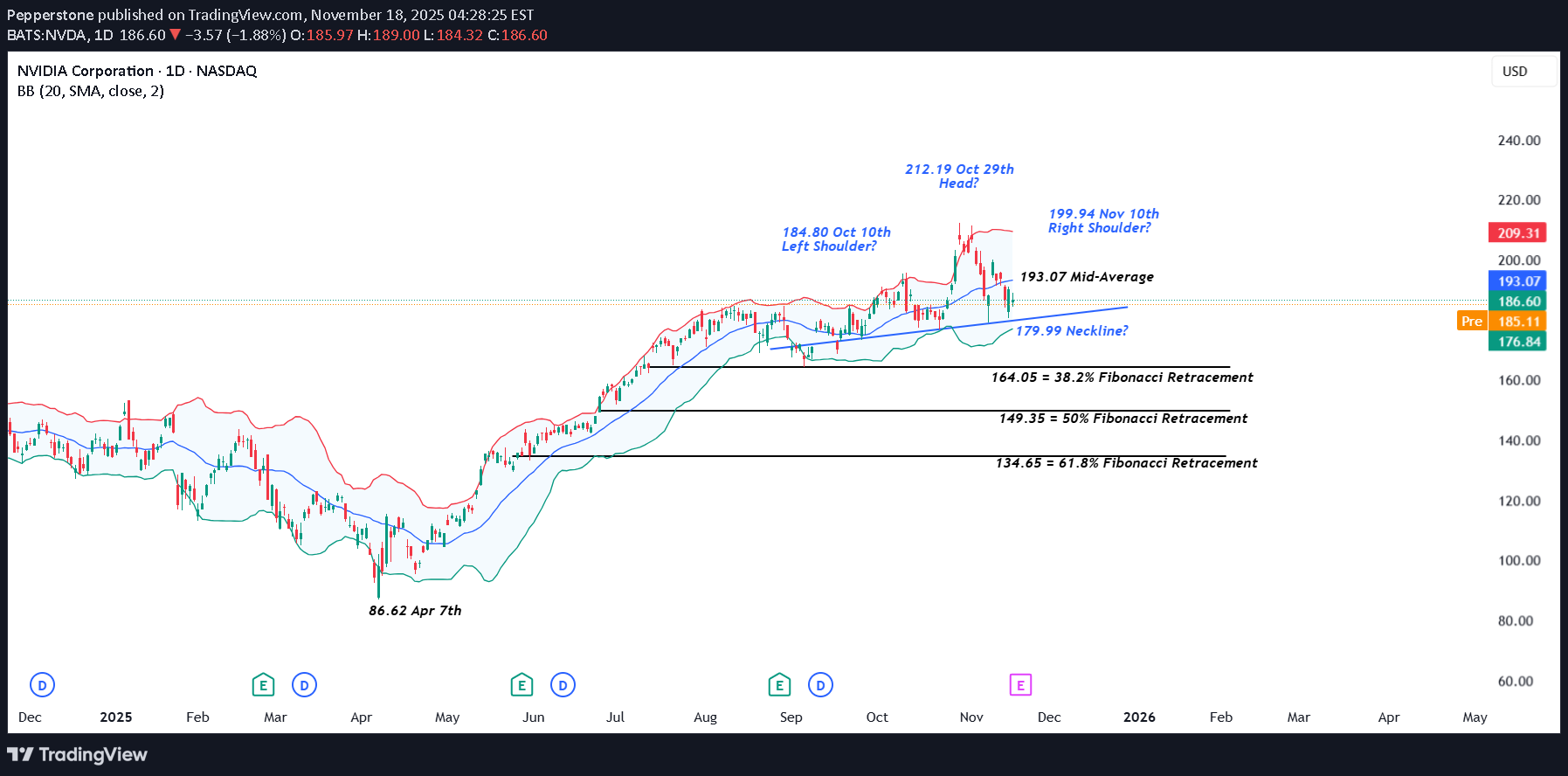
There is no getting away from it, NVIDIA’s earnings, which are due on Wednesday after the close are making traders nervous. The problem with being the largest company in the world by market capitalisation (approx.$4.53 trillion) with a roughly 7.5% weighting in the S&P 500 and closer to 10% weighting in the Nasdaq 100 is that everything related to your company matters, especially when you are seen as the global AI benchmark at a time when traders are wondering if lofty valuations given to the leading companies in the space are justified or not. Suddenly, stories like Softbank selling its entire NVIDIA stake of $5.8 billion last week, gets more headline space in the financial press and now your Q3 earnings are potentially being seen as important to the direction of market sentiment and risk appetite as whether the Federal Reserve decides to cut interest rates again at its final meeting of the year on December 10th. The earnings, when they are released are anticipated to be strong, with Reuters reporting analysts expecting an average 54% year on year rise on Q3 earnings per share. However, while traders may be judging the actual results against market expectations, they may also be keen to hear the updates from CEO Jensen Huang regarding future revenue and chips sales moving forward. With the potential for extra volatility in NVIDIA’s share price across the next 48 hours being apprised of the technical backdrop could be important. Technical Update: Limited Correction or Sentiment Shift? It has been a choppy period for the Nvidia share price since mid-September 2025, activity that has seen 3 distinct highs in price posted. As the chart below shows, these stand at 184.80 on October 10th, 212.19 from October 29th and 199.94, scored on November 10th. As you can also see on the chart, the 2nd of these 3 peaks at 212.19, is higher than the other 2, which is important from a technical perspective. This may lead some analysts to suggest this activity could be forming a potential Head and Shoulders top pattern. It is important to stress that a Head and Shoulders pattern must be completed by a close below the ‘neckline’ or the trend connecting recent price lows, which in the case of Nvidia currently stands at 179.99. Even then, completion of such a pattern isn’t a guarantee of a sentiment shift, but as we approach Nvidia earnings on Wednesday, risks may turn towards increased price volatility, and being aware of potentially relevant support and resistance levels may prove useful. [bWhat if Closes Below 179.99 Support are Seen?: Having seen recent price weakness held and reversed to the upside by the uptrend currently standing at 179.99, this could now be viewed as the first support focus. However, with it also possibly being the neckline of a potential Head and Shoulders pattern, it may prove to be pivotal moving forward. While there is no guarantee closes that below the support at 179.99 may lead to a further phase of price weakness, it might skew risks towards continued declines. Focus may then turn towards 164.05, a level equal to the 38.2% retracement level of April to October strength, possibly even towards 149.35, which is the 50% retracement. What if 179.99 Support Remains Intact?: As already said, any Head and Shoulders pattern must see closes below neckline support to suggest a completion and risks for further price declines. For Nvidia the 179.99 support is still intact on a closing basis, and it could be argued this is not yet a valid reversal pattern. As such, while the 179.99 level holds, traders may view recent price declines as a limited correction within what could still be classed as an uptrend in price. However, if a further phase of price strength is to materialise, traders may require closes back above the still rising Bollinger mid-average currently at 193.07. Such moves if seen, could then lead to tests of 199.94 the November 10th high, even on towards 212.19, the October 29th extreme. The material provided here has not been prepared accordance with legal requirements designed to promote the independence of investment research and as such is considered to be a marketing communication. Whilst it is not subject to any prohibition on dealing ahead of the dissemination of investment research, we will not seek to take any advantage before providing it to our clients. Pepperstone doesn’t represent that the material provided here is accurate, current or complete, and therefore shouldn’t be relied upon as such. The information, whether from a third party or not, isn’t to be considered as a recommendation; or an offer to buy or sell; or the solicitation of an offer to buy or sell any security, financial product or instrument; or to participate in any particular trading strategy. It does not take into account readers’ financial situation or investment objectives. We advise any readers of this content to seek their own advice. Without the approval of Pepperstone, reproduction or redistribution of this information isn’t permitted.
عملکرد سهام انویدیا (NVDA) قبل و بعد از اعلام گزارشهای مالی: آمار و ارقام کلیدی
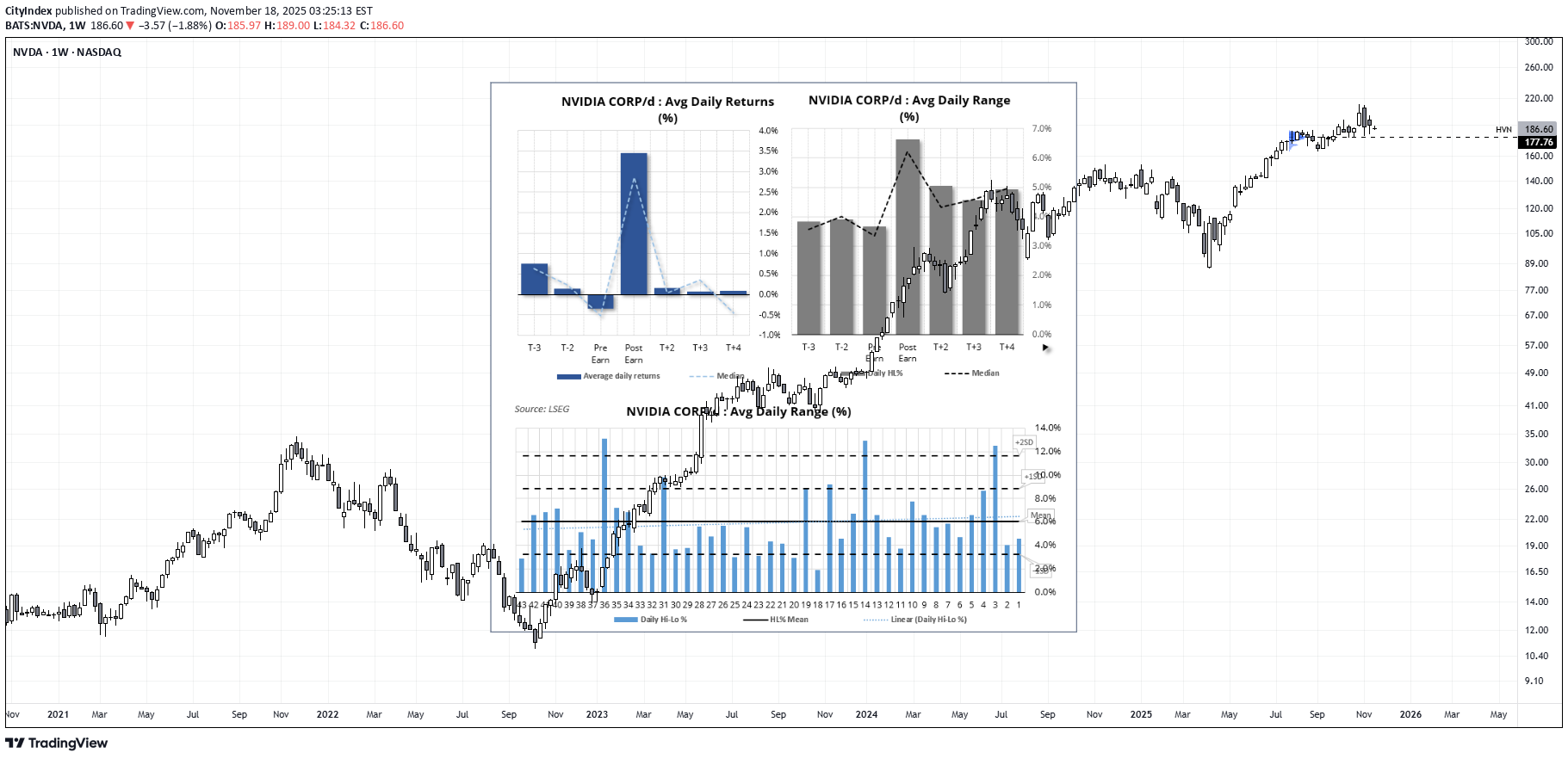

SwingTraderPhilTV
هشدار بزرگ: انویدیا در آستانه سقوط 25 درصدی! آیا زمان فروش (شورت) فرا رسیده است؟
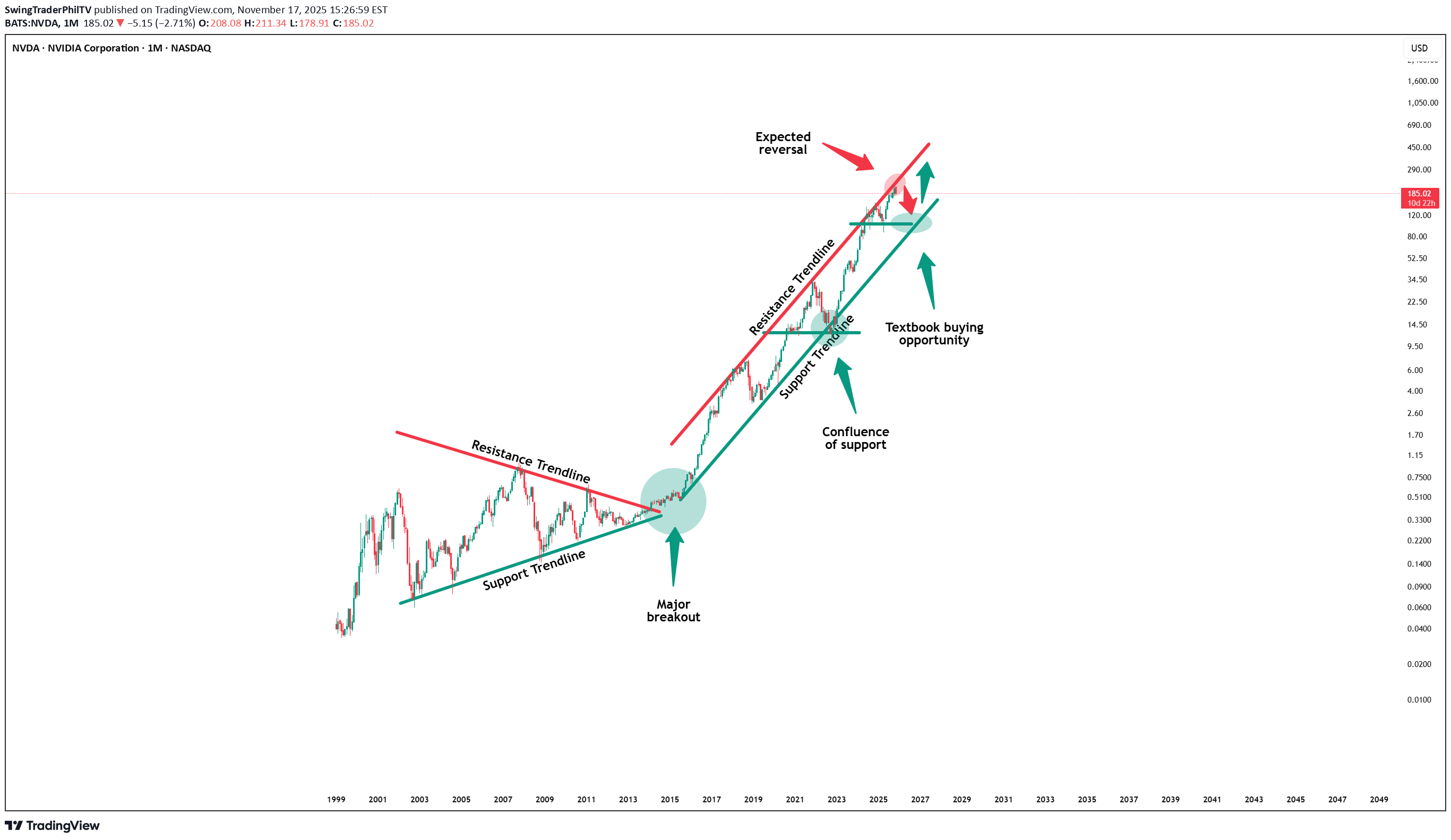
💣انویدیا ( NVDA ) اکنون در حال ایجاد یک تاپ است: 🔎خلاصه تحلیل: همین چند روز پیش، انویدیا به طور کامل خط روند مقاومت major را دوباره آزمایش کرد. همیشه در گذشته، چنین آزمایش مجدد با علامت major move به سمت منفی دنبال می شد. بنابراین، انویدیا در حال آماده شدن برای کاهش major است که می تواند منجر به کاهش -25٪ دیگر در آینده شود. 📝سطوح قابل تماشا: 180 دلار و 140 دلار و 100 دلار SwingTraderPhil SwingTrading. Simplified. | سرمایه گذاری.ساده شده. | #دید طولانی مدت

quantsignals
سیگنال فروش پنهان برای انویدیا (NVDA): آیا خریداران کم آوردند؟
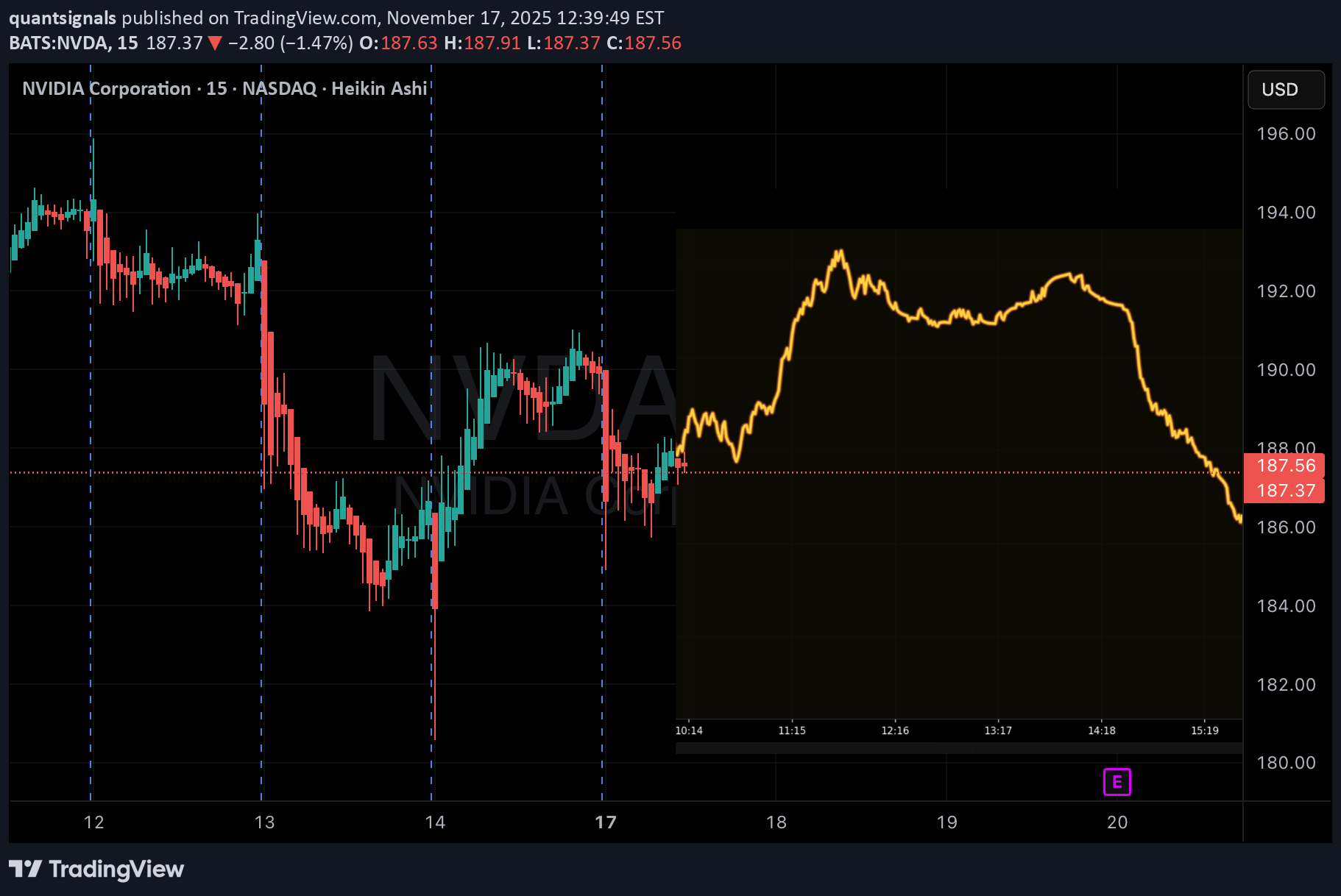
NVDA (QuantSignals V3) ساختار بازار: NVDA حرکت خنثی به ضعیف را با قیمت نزدیک به مقاومت کوتاه مدت در 189-190 دلار نشان می دهد. خریداران در حال از دست دادن قدرت هستند و نوار ساختارهای پایین تر را نشان می دهد که نشان دهنده خستگی بالقوه است. چشم انداز روند: مدل Katy 1M دارای فشار نرم نزولی است. علیرغم خواندن روند خنثی، ساختار درون روز به سمت عقب نشینی کنترل شده متمایل می شود که توسط نوسانات متوسط (16.5٪) پشتیبانی می شود. سفارش Flow Insight: به نظر می رسد که مومنتوم flow کند می شود، با کاهش حجم به سمت بالا. روند خرد نشان میدهد که رفتار کمرنگتر را نشان میدهد - تجمعهای کوچک ممکن است فروخته شوند. سطوح کلیدی: مقاومت: 189.40 دلار / 191.70 دلار پشتیبانی: 188.00 دلار / 186.80 دلار منطقه ماشه کوتاه: 188.50 تا 189.00 دلار Vision خلاصه: NVDA شتاب کمتر، اعتقاد ضعیف خریدار، و یک ریز شیفت کوتاه مدت را نشان میدهد. بهترین راهاندازی با اسکالپ کوتاه محکم که جیب نقدینگی بعدی زیر 188.00 دلار را هدف قرار میدهد هماهنگ است.

FXTraderPaul
گزارش درآمد انویدیا (NVDA): آیا این هفته سهم به اوج میرسد یا سقوط میکند؟
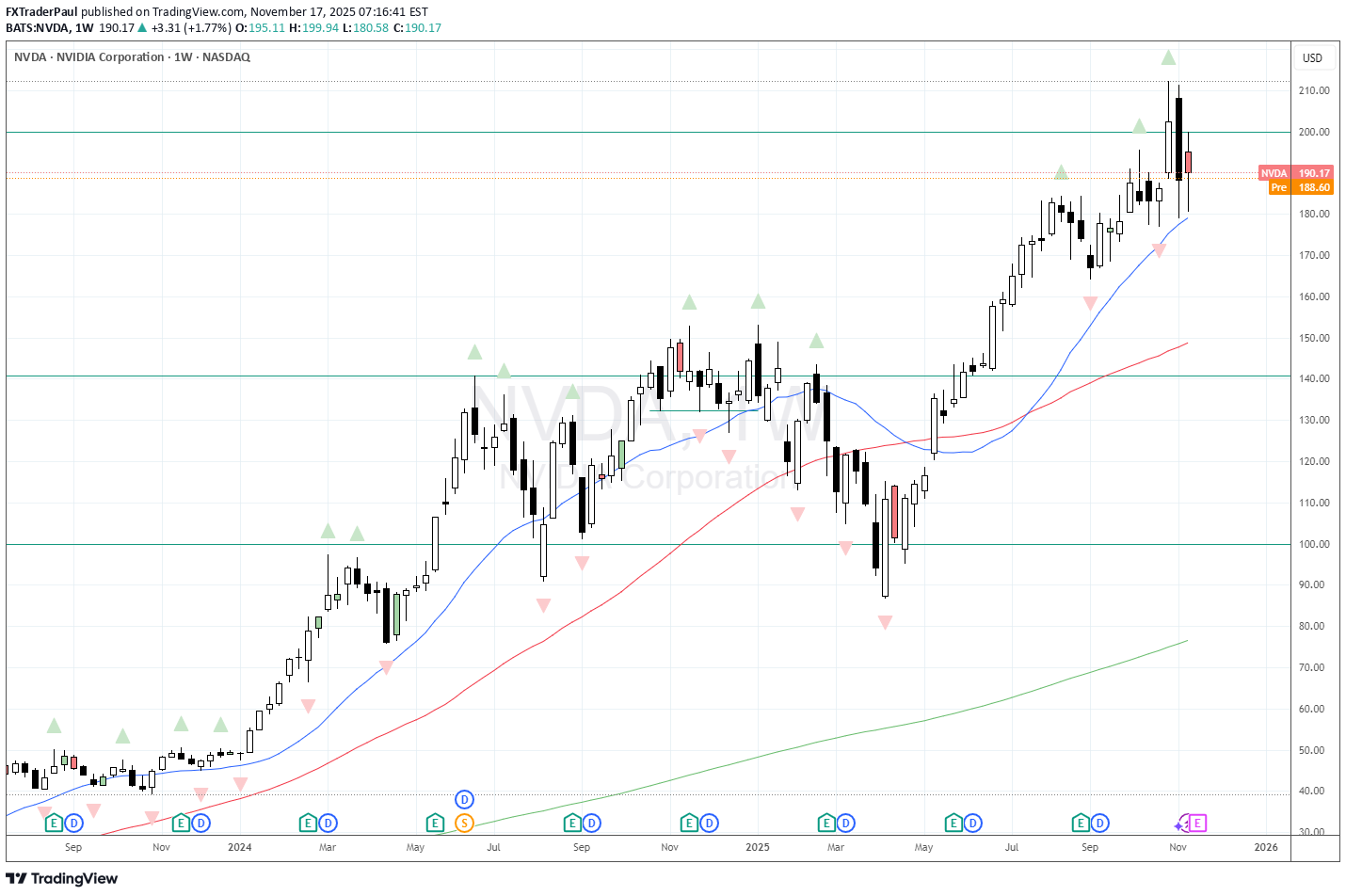
چند ماه دیگر از حرکت های صعودی عالی در NVDA گذشته است، با این حال چند هفته اخیر متلاطم بوده است. ما سطح 200 دلار را رد کردیم و اکنون متوجه شدیم که بالای 180 دلار و هفتگی 20MA نشسته ایم. اگر اعداد خوب باشند، مطمئنم که سرگیجه ما را بالاتر برد. اگر اعداد ضعیف هستند، باید بپرسید 180 دلار و Weekly 20MA act به عنوان پشتیبانی بود، یا سقوط کرد؟ اگر این کار را انجام دهند، چه اتفاقی برای بازارهای فناوری و ایالات متحده به طور کلی افتاد؟ یعنی هفته جالبی بود!
پیشبینی حرکت قیمت انویدیا (NVDA) پیش از اعلام نتایج: تحلیل تکنیکال و انتظارات بازار
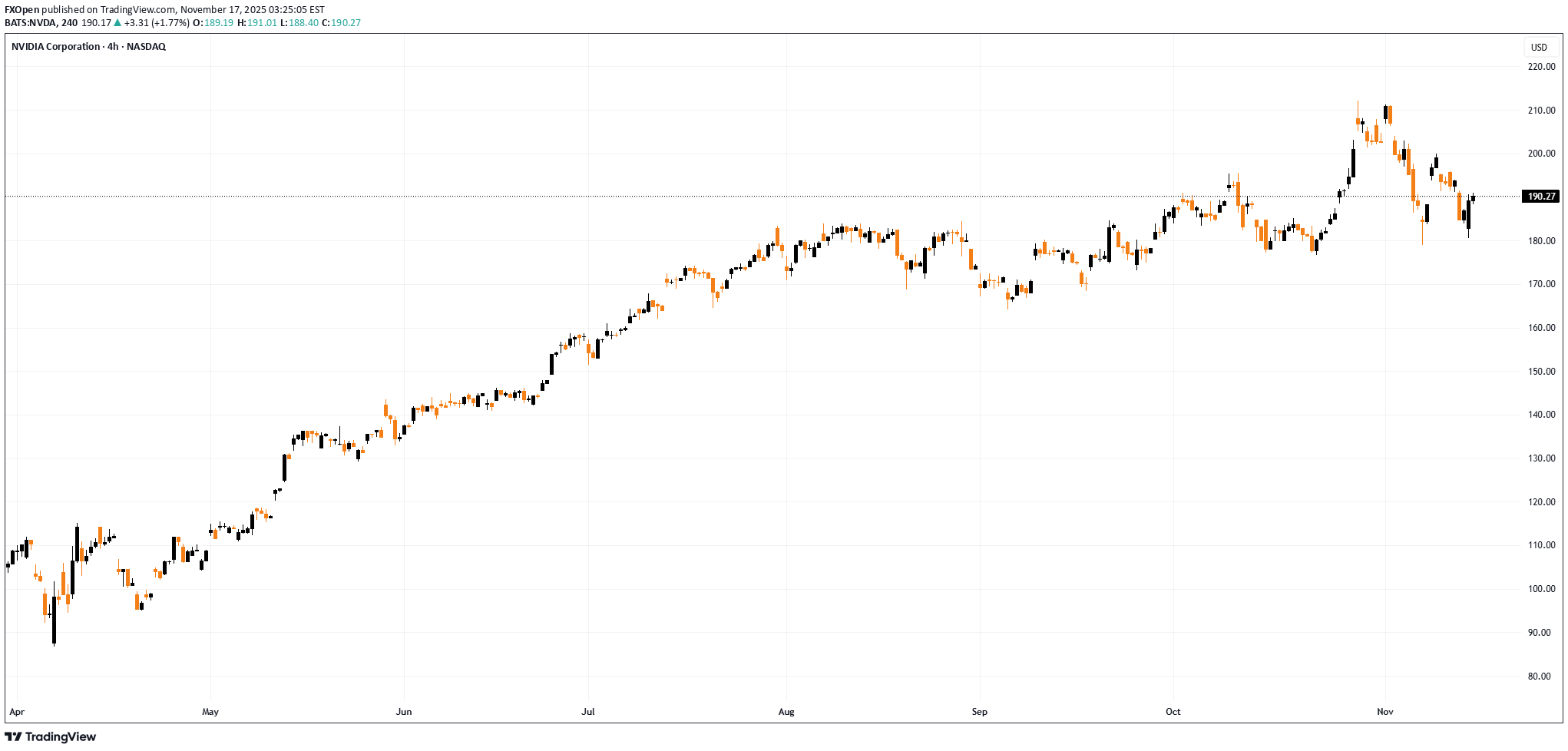
در آستانه گزارش مالی انویدیا (NVDA): قیمت چگونه میتواند تغییر کند روز چهارشنبه، پس از پایان جلسه معاملاتی اصلی ایالات متحده، انویدیا نتایج فصلی خود را منتشر کرد — گزارشی که صرفاً مجموعهای دیگر از دادههای شرکتی نیست، بلکه آزمونی حیاتی برای کل روند صعودی (بازار گاوی) مبتنی بر هوش مصنوعی محسوب میشود. سهام NVDA از ابتدای سال بیش از 40 درصد افزایش یافته است، و اکنون شرکت باید ثابت کند که این جهش موجه است و انقلاب هوش مصنوعی هنوز در حال شتاب گرفتن است. طبق گزارشهای رسانهای، تحلیلگران وال استریت همچنان خوشبین هستند: ← درآمد: پیشبینی حدود 54.9 میلیارد دلار، که تقریباً 56 درصد رشد سال به سال را نشان میدهد. ← سود هر سهم (EPS): حدود 1.25 دلار (فصل قبل: 1.05 دلار). سرمایهگذاران باید بر چه چیزی تمرکز کنند؟ موارد زیر از اهمیت ویژهای برخوردار بود: ← تمرکز بر درآمد بخش مراکز داده، یک شاخص کلیدی برای اینکه آیا رونق هوش مصنوعی همچنان پابرجا است یا خیر؛ ← پیشبینیهای آتی (راهنماییهای شرکت)، زیرا بازار به دنبال اطمینان از این است که شرکتهای بزرگ فناوری همچنان به شدت بر روی زیرساختهای هوش مصنوعی هزینه کرد. تحلیل تکنیکال نمودار انویدیا (NVDA) رفتار اخیر قیمت در سهام NVDA به دنبالهای اشاره دارد که میتواند نزولی تفسیر شود: ← 28 اکتبر: یک صعود قوی بالای سطح روانی 200 دلار؛ ← عدم موفقیت در حفظ شدن بالای آن مانع؛ ← یک عقبنشینی با افزایش حجم معاملات (بازار نزدک) و کندلهای گسترشیابنده در اوایل نوامبر. در بستر گستردهتر بازار، قابل توجه است که اوایل نوامبر شاهد عملکرد ضعیفتر NVDA نسبت به شاخصهای اصلی سهام بوده است، که نشاندهنده مقاومت قوی فروشندگان در حدود 200 دلار است. از دیدگاه صعودی، کاهش قیمت از بالاترین رکورد تاریخی شبیه به یک الگوی اصلاحی است (نشان داده شده در نمودار) در یک روند صعودی بزرگتر. با این حال، این خطر وجود دارد که انتظارات بالای بازار پس از انتشار گزارش سود برآورده نشود. اگر این اتفاق بیفتد، NVDA میتواند کاهش خود را به سمت مرز پایینی کانال صعودی، جایی که حمایت نزدیک 165 دلار قرار دارد، گسترش دهد. این مقاله صرفاً بیانگر نظر شرکتهایی است که تحت برند FXOpen فعالیت میکنند. این مطلب نباید به عنوان پیشنهاد، درخواست یا توصیه در رابطه با محصولات و خدمات ارائه شده توسط شرکتهای فعال تحت برند FXOpen، یا به عنوان مشاوره مالی تلقی شود.

BullBearInsights
آیا انویدیا (NVDA) پس از ریزش سنگین، تثبیت شد؟ تحلیل سطوح حیاتی و رازهای پشت جهش قیمت
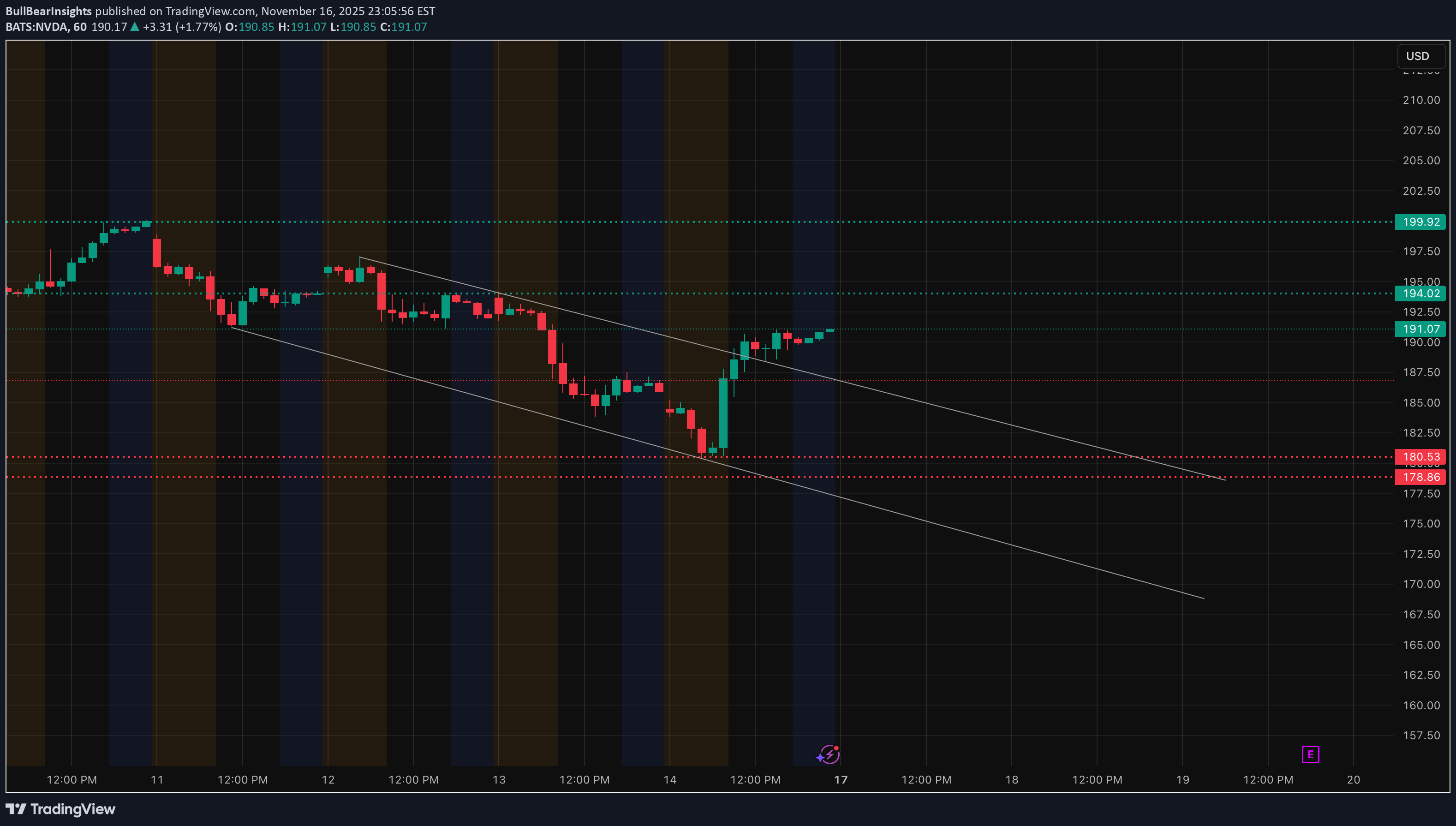
NVDA سرانجام پس از چندین روز فروش کنترل شده، اولین نشانه واقعی تثبیت را نشان داد. پایین آمدن move تصادفی نبود - وقتی روی تایم فریم های مختلف زوم می کنید و آن را با چشم انداز GEX ترکیب می کنید، جهش در واقع بسیار منطقی است. NVDA مستقیماً در یک منطقه deep قرار گرفت، پایین آمد و سپس با قصد به عقب برگشت. بیایید آنچه را که واقعاً در اینجا اتفاق میافتد، تجزیه کنیم. 1️⃣ نمودار 1 ساعته - روند نزولی، اما خریداران در نهایت افزایش یافتند نمودار 1H نشان می دهد که NVDA هر روز پشتیبانی جزئی را شکسته و به طور تمیز در کانال نزولی می لغزد. فشار فروش تنها زمانی کاهش یافت که قیمت منطقه 178–181 را لمس کرد. آنجاست که حمایت خط روند با جیب های نقدینگی قبلی روبرو شد و خریداران فوراً واکنش نشان دادند. نکته قابل توجه این است که NVDA با چه سرعتی به 190 بازگشت. این دو چیز را به من می گوید: 1. فروشندگان به شدت در سطح پایین پوشش داده می شوند. 2. خریداران منتظر بودند تا نزدیک به آن خط روند وارد شوند. سطوح مهم 1H: * 190-192: اولین تست مقاومت * 194-195: NVDA منطقه بحرانی را دفعه قبل نتوانست بازیابی کند * 199-202: مقاومت بزرگتر در صورت گسترش حرکت * 178–181: منطقه تقاضای قوی که شروع به جهش کرد 1H اولین تغییر را از "مستقیم به پایین" به "جهش کنترل شده" نشان می دهد. 2️⃣ نمودار 15 دقیقه ای - حرکت به سمت بالا، اما نیاز به تایید دارد نمودار 15M NVDA را نشان می دهد که چندین FVG صعودی کوچک را در راه صعود بازپس می گیرد. مهمترین بخش این است که NVDA چگونه عقبنشینیهای روزانه را مدیریت میکند – هر فرورفتگی کم عمق بود و به سرعت خریداری میشد. این همان چیزی است که رفتار معکوس اولیه به نظر می رسد. چیزهای کلیدی که در 15M می بینم: * FVG های صعودی در حال شکل گیری زیر قیمت → خریداران در حال جذب شیب ها * مقاومت کوتاه مدت در 191–192 → قیمت در اینجا تردید دارد * بازیابی خط روند به NVDA فضای بیشتری برای آزمایش می دهد 15M هنوز یک روند صعودی قوی را تایید نمی کند، اما نشان دهنده یک تغییر واضح در شخصیت از فروشندگان مسلط به خریداران حداقل رقابت کننده است. 3️⃣ GEX (1 ساعته) - دقیقاً توضیح می دهد که چرا NVDA پایین آمده است این قسمتی است که کل move را به هم متصل می کند. NVDA دقیقاً در دیوار deep PUT در حدود 178-181، جایی که فشار پوششی افزایش مییابد، برگشت. به همین دلیل است که برگشت در آنجا بسیار شدید بود. سطوح گاما بالا * 191: اولین کشش GEX * 194-195: خوشه GEX سنگین * 200–203: دیوار تماس دوم * 210: دیوار بزرگ GEX10 + 3rd call اگر NVDA بتواند 194-195 را بازیابی کند، move به سمت 200-203 بسیار ساده تر از آن چیزی است که به تنهایی در نمودار به نظر می رسد. سطوح پایین گاما * 182: منطقه محوری * 178: دیوار اصلی - سطح دقیقی که فروش را متوقف کرد * 175–170: فقط در صورتی فعال می شود که NVDA 178 را قاطعانه از دست بدهد ساختار GEX تمیز است: * فروشندگان قدرت بالای 192 را از دست می دهند * خریداران کنترل زیر 182 را از دست می دهند * منطقه نبرد واقعی بین 188-192 قرار دارد این همان نقشه GEX است که باعث می شود معامله گران بپرسند: "چرا NVDA همیشه در همان سطوح عجیب و غریب جهش یا توقف می کند؟" (و بله - GEX پاسخ می دهد.) 🎯 چگونه NVDA را برای 17/11 معامله می کنم 🔼 سناریوی صعودی (فقط ترجیح داده شده بالاتر از 192) NVDA باید 192 را با قدرت پاک کند. اگر این اتفاق بیفتد: ایده تجارت سهام: * ورودی: 192.20-192.50 * اهداف: * 194 * 195 * 198 * 200-203 (منطقه دیوار تماس) ایده گزینه ها: * 195 درجه سانتیگراد یا 200 درجه سانتیگراد * تجارت مبتنی بر مومنتوم IF NVDA 192 را با حجم بازپس گرفت * مقیاس در هر منطقه GEX این تمیزترین راه اندازی است. 🔽 سناریوی نزولی (فقط در صورتی معتبر است که NVDA 192 را رد کند یا 182 را از دست بدهد) ورودی شماره 1 (تهاجمی): * رد 192 → کوتاه به 188 ورودی شماره 2 (تأیید قوی تر): * شکستن به زیر 182 اهداف: * 180 * 178 (دیوار مستحکم) * 175 (در صورت افزایش نوسانات) ایده گزینه ها: * 185P برای حرکات سریع * 180P برای ادامه * زیر 178 → نزولی به شدت شتاب می گیرد ⚠️ Chop Zone: 188–191 این منطقه تعادلی است که NVDA احتمالاً در آن مکث میکند، جعل میکند و هر دو طرف را به دام میاندازد. بهتر است از این کار خودداری کنید مگر اینکه در معرض خطر شدید پوست سر قرار بگیرید. افکار نهایی NVDA سرانجام پس از یک سری طولانی از اوج ها و پایین ترین قیمت ها، قیمت واقعی را به دست آورد. پرش تصادفی نبود - با دیوارهای deep GEX و خط روند ساختاری همسو شد. اکنون NVDA دقیقاً زیر یک مقاومت کلیدی در 192 قرار دارد. این خطی است که تصمیم میگیرد که آیا این یک معکوس واقعی است یا فقط یک اوج پایینتر دیگر در روند نزولی. بالای 192 → نمودار به زیبایی باز می شود. زیر 182 ← خرس ها کنترل را پس می گیرند. هر چیزی بین آن نویز است. سلب مسئولیت این تجزیه و تحلیل فقط برای اهداف آموزشی است و به منزله مشاوره مالی نیست. همیشه با مدیریت ریسک مناسب معامله کنید.

Serana2324
تحلیل تکنیکال NVDA: آیا قیمت به حمایت مهم 167-155 دلار میرسد؟
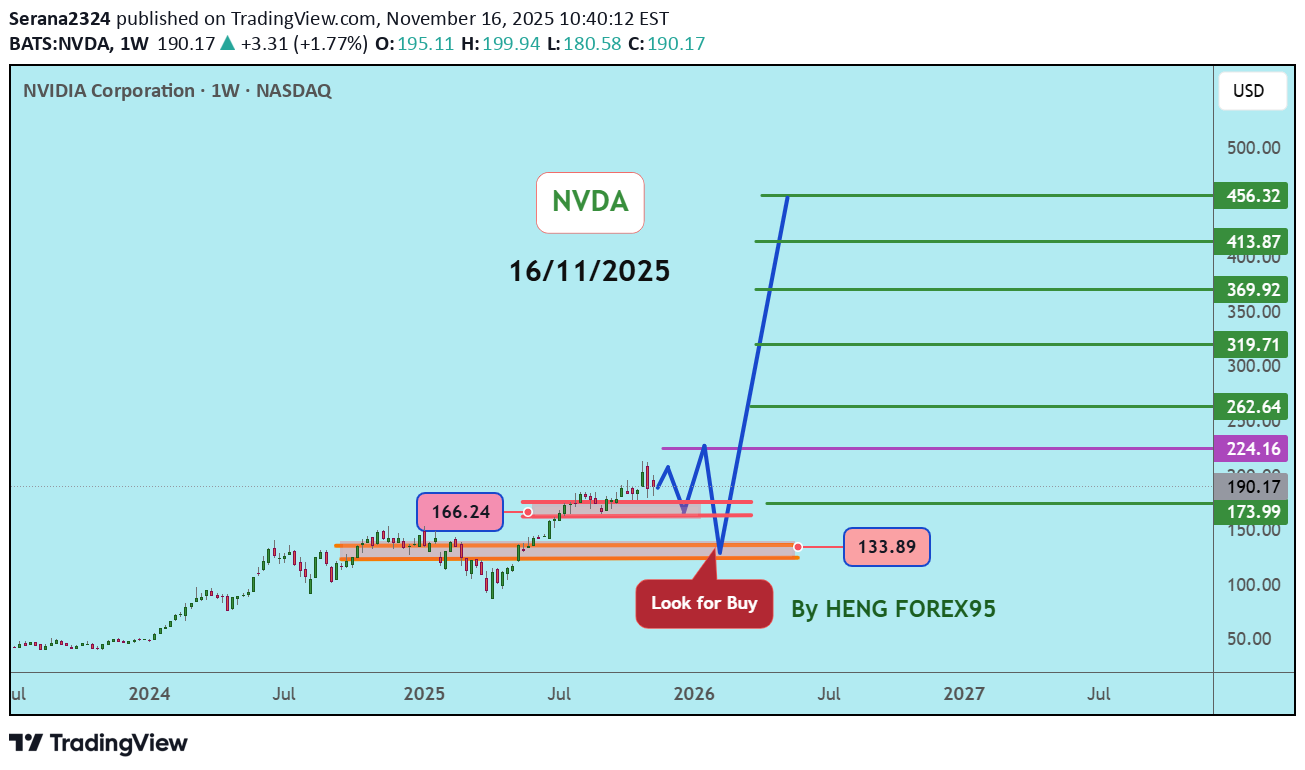
انویدیا همچنان در یک روند صعودی قرار دارد. هفته گذشته، قیمت به سقف جدید ۲۱۰ دلار رسید، اما نتوانست از این سطح عبور کند، بنابراین اصلاحی رو به پایین داشت. انتظار میرود که قیمت به احتمال زیاد منطقه حمایتی مهم در محدوده ۱۵۵-۱۶۷ دلار را آزمایش کند. اگر قیمت نتواند از ۱۵۵ دلار پایینتر رود، همچنان شانس صعود دارد. با این حال، اگر قیمت در آینده نزدیک به روند صعودی خود ادامه دهد، احتمال وقوع یک اصلاح نیز وجود دارد. برنامه معاملاتی بلندمدت: قبل از خرید، منتظر تکمیل شدن اصلاح باشید. ** این توصیه مالی نیست. 🔥معاملات آتی، فارکس، CFD و سهام، خطر زیان را به همراه دارد. لطفاً با دقت بررسی کنید که آیا چنین معاملاتی برای شما مناسب است یا خیر. >>موفق باشید 😊 ❤️ لایک و مشترک شدن را فراموش نکنید تا هیچ ایده جدیدی را از دست ندهید!

iamzr
نتیجه گزارش انویدیا (NVDA) چه میشود؟ پیشبینی غیرمنتظره برای شاخص نزدک ۱۰۰
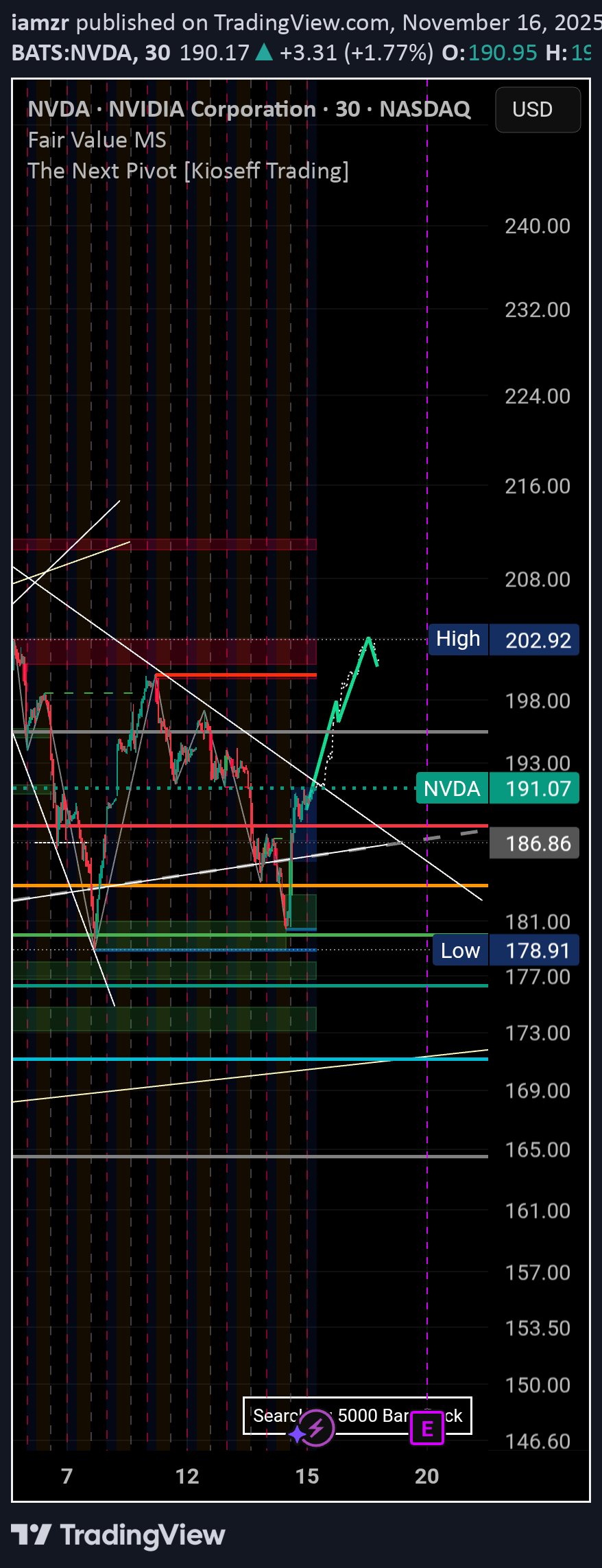
سود انویدیا (NVDA) مطابق انتظار بود، اما نیازی به احتیاط نیست.

Bfinance-2025
انفجار انویدیا (NVDA) در گزارش مالی: آیا این آخرین جهش بزرگ قبل از ریزش است؟
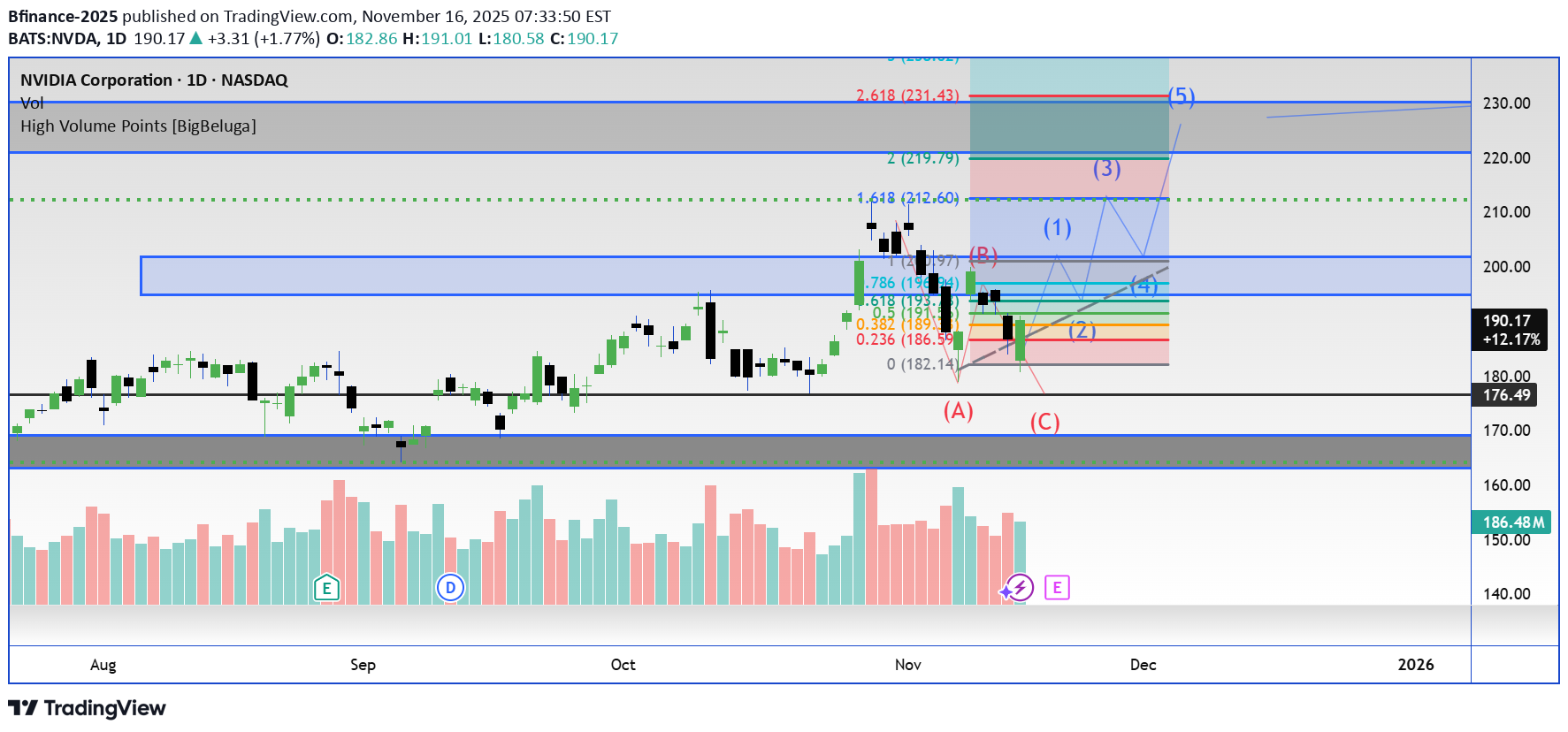
انویدیا (Nvda) گزارش درآمدش (ER) را با قدرت درهم شکست؛ ما شاهد یک موج صعودی (ایمپالس) عظیم بود! من فروش با حجم بالا در تایمفریم روزانه نمیبینم. فکر میکنم این آخرین جهش بزرگی باشد که قبل از یک اصلاح (Correction) [X] درصدی مشاهده میکنیم. تمامی هایپراسکِیلرهای دیگر عملکرد خوبی داشتهاند و گپهای قیمتی در زمان گزارش درآمدشان ایجاد کردهاند. نوبت انویدیاست، این را نشانهگذاری کن!!
سلب مسئولیت
هر محتوا و مطالب مندرج در سایت و کانالهای رسمی ارتباطی سهمتو، جمعبندی نظرات و تحلیلهای شخصی و غیر تعهد آور بوده و هیچگونه توصیهای مبنی بر خرید، فروش، ورود و یا خروج از بازارهای مالی نمی باشد. همچنین کلیه اخبار و تحلیلهای مندرج در سایت و کانالها، صرفا بازنشر اطلاعات از منابع رسمی و غیر رسمی داخلی و خارجی است و بدیهی است استفاده کنندگان محتوای مذکور، مسئول پیگیری و حصول اطمینان از اصالت و درستی مطالب هستند. از این رو ضمن سلب مسئولیت اعلام میدارد مسئولیت هرنوع تصمیم گیری و اقدام و سود و زیان احتمالی در بازار سرمایه و ارز دیجیتال، با شخص معامله گر است.
